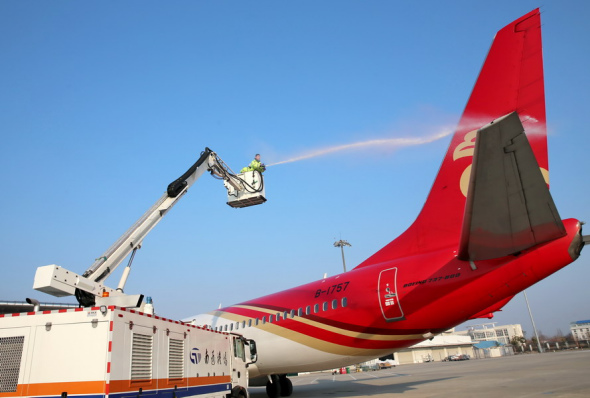
An employee carries out ice prevention operations on an airplane at the Nantong Xingdong International Airport in Jiangsu province. (Photo by Xu Congjun/For China Daily)
Legendary Chinese engineer Lu Ban is believed to have created a flying wooden bird in ancient times.
Today, Zhao Boyou said he makes "nests" for aircraft.
"People need to rest after working hard. So do aircraft. Jumbos need spacious hangars," said Zhao, the 47-year-old vice-chief structural engineer of China Aviation Planning and Design Institute, part of the State-owned industry giant Aviation Industry Corporation of China, Ltd.
His team is making a big column-free hangar - able to "nest" about 11 civil aircraft - at Beijing's new airport.
"We create hangars for aircraft 'health checks', maintenance, repairs and overhaul," Zhao said. The maintenance hangar for China Southern Airlines will set an Asian record. It will be 405 meters across, 100 meters deep, and have a clearance height of 30 meters.
Those dimensions are about 46 meters wider than the current Asian record holder: the A380 hangar at Beijing Capital International Airport, also created by CAPDI.
"It will hold two A380 jumbos, three B777 wide-body aircraft and six narrow-bodies, such as the B737 or A320," Zhao said, sketching a rectangular building. "And about 1,200-tonne maintenance facilities will be suspended from the roof."
CAPDI has designed more than 95 percent of the civil aircraft maintenance hangars in China, and all the painting hangars.
The need for those hangars is evident: China's civil aviation industry is mushrooming in fleet size and passenger and cargo loads.
At the end of 2017, the civil fleet stood at 3,296 aircraft and the industry logged more than 10 million flight hours for the first time, according to the Civil Aviation Administration of China.
"After arriving at your destination, have you ever thought of where the plane goes?" asked Zheng Yingping, executive deputy director of the Civil Aviation Engineering Design and Research Institute of CAPDI.
"It's the hangar, a place for aircraft rest and restoration for the next trip. Safety is the lifeline of civil aviation, and the hangar is a critical point to ensure safety," Zheng said.
Beijing's new airport, which will relieve pressure on Beijing Capital International Airport, is 46 kilometers from the downtown area and is expected to start test operations in late 2019.
But more airports mean more pressure on construction land.
The long-span hangar is the "secret weapon", the most feasible and economical solution to meet the challenges, Zheng said.
"We are exploring creative methods to make bigger, longer hangars, but lighter and stronger in structure," Zhao said. The long-span hangar is more than just a "big building with a massive roof".
It is a functional building with cradles and suspension equipment, tailored to huge aircraft bodies and maintenance services.
An array of pipelines will supply power, water, ventilation, gas and other necessities.
"It is a huge challenge for engineers to balance strength and flexibility," Zhao said.
Numerous other factors such as costs, land area and time limits are also in their minds.
As hangars are mostly built near runways, height is severely restricted. However, traditional hangars have "big heads", a gate truss structure to support the roof.
But the cost of a "big head" for the super hangar was prohibitive.
"We tried and experimented time and again. Finally, we got a creative design that adopted high-strength cables for leverage," Zhao said.
The patented design will also require about 1,500 tonnes of steel less than the traditional design, enough to build a hangar roof the size of a football field.
CAPDI has previously set records with its 80-meter maintenance hangar in Guangzhou province in 1985, the 352-meter A380 hanger in Beijing in 2005, and a group of hangars at Shanghai's Pudong Airport in 2006.
"China has ambitions to integrate into the global aviation industry chain. China-developed aircraft are flying overseas, and so are our creative designs and engineering services," said CAPDI Chairman Lian Dawei.
"We've cast our eyes over the markets of Africa and Southeast Asia, supporting them to fly higher with 'China span' and 'China speed'."


















































